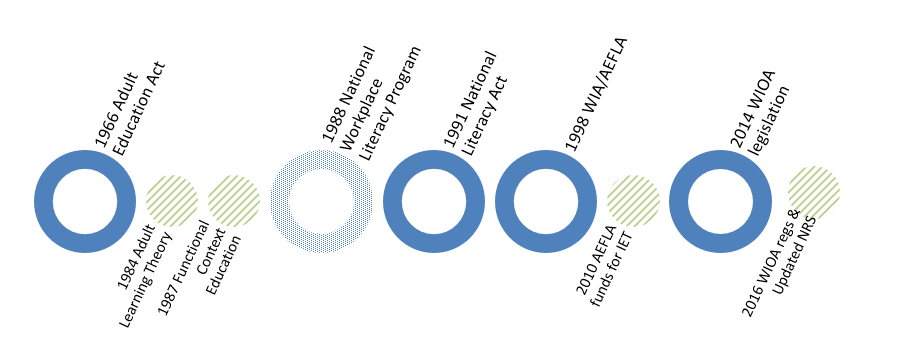Adult Education is Evolving through Theory, Legislation, and Innovative Practice
By Judy Mortrude

Adult education provides the skills people need to thrive in their families, communities, and jobs. As we celebrate Adult Education and Family Literacy (AEFL) week, it is useful to look back at how the program has evolved over the last 50 years through theory, legislation, and innovative practice.
Congress first began investing in adult education in 1966 when it passed the Adult Education Act. Since then, researchers and policy experts have worked to better refine our understanding of what works in adult education. Much of that work is grounded in adult learning theory like Malcolm Knowles’ four principles of andragogy
- adults need to be involved in planning and evaluating their learning;
- experience, including mistakes, is the basis for learning;
- immediately relevant learning is most interesting to adults; and
- adult learning is problem-centered rather than content-centered
and Thomas Stitch’s concept of functional context education In testimony to Congress, Stitch said:
We could be teaching … literacy skills within the context of natural sciences, life sciences, but we don’t do that, because there’s the myth that says literacy is something you first get and then have to apply. Of course that is totally wrong. You get it while you apply it.
Stitch was persuasive and so from 1988 to 1994, Congress invested $120 million in adult education through the National Workforce Literacy Program, a work-based program aimed at improving adults’ workplace literacy skills. In 1991, President George H.W. Bush signed the National Literacy Act, calling it a major step toward the goal of adult literacy and lifelong learning. And in 1998, Congress passed the Workforce Investment Act (WIA), which created the Adult Education and Family Literacy Act (AEFLA) and established the one-stop system to align adult education with other local education and workforce partners.
WIA fostered a great deal of innovation. In 2010, the U.S. Department of Education released guidance on using federal AEFLA funds for Integrated Education and Training (IET). IET is a concurrent/co-enrollment/dual enrollment strategy for adults. It looks beyond high school completion to supporting postsecondary success. Exemplar adult education programs began incorporating this model.
In 2014, Congress passed the Workforce Innovation and Opportunity Act (WIOA) to help people with employment barriers access education, training, and supportive services that prepare them to succeed in the labor market. WIOA reauthorized the AEFLA program.
Under WIOA, the AEFLA program has increased adults’ educational and workforce development opportunities, recognizing their needs as workers, parents, and community members. In addition to helping adults complete high school credentials, the program helps them transition to postsecondary education and succeed in training through the use of career pathways.
WIOA also requires states and localities to create career pathways. CLASP has played a key role in helping them develop strategies. Most recently, in July 2018, CLASP convened state education and workforce development leaders, national organizations, advocates, funders, and federal agency staff to share perspectives on four critical areas of career pathway work:
- Career & guided pathways alignment;
- Increasing the use of Ability to Benefit;
- Leveraging career pathways to advance racial equity; and
- Measuring success through career pathway research.
The briefs highlight lessons from the convening, new research, and offers new perspective on what’s working, what isn’t, and collaboration opportunities for states to provide better career pathways.